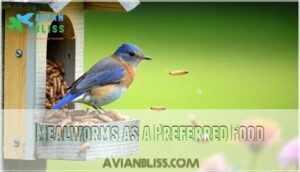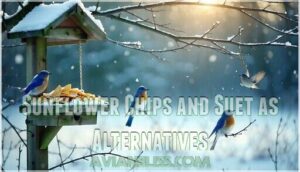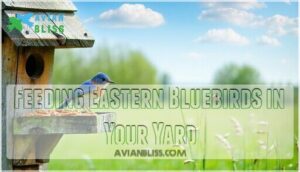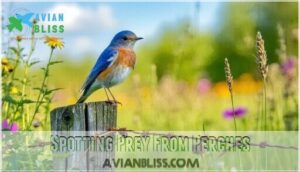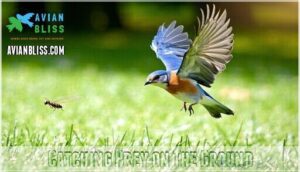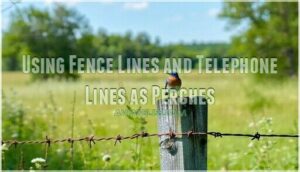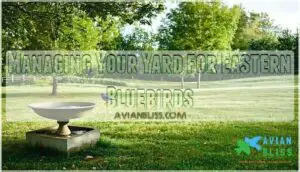This site is supported by our readers. We may earn a commission, at no cost to you, if you purchase through links.

When winter arrives, they shift gears and rely heavily on native fruits like elderberries and dogwood berries for essential energy reserves. Spiders contribute about 11% of their intake, while earthworms round out their nutritional needs.
Their dietary flexibility is like having a well-stocked pantry that changes with the seasons, ensuring survival through harsh conditions and successful breeding.
Table Of Contents
- Key Takeaways
- Eastern Bluebirds Diet Overview
- Favorite Foods of Eastern Bluebirds
- Feeding Eastern Bluebirds in Your Yard
- Eastern Bluebirds Diet by The Numbers
- Eastern Bluebirds Foraging and Hunting Techniques
- Managing Your Yard for Eastern Bluebirds
- Creating a Bluebird-Friendly Yard
- Frequently Asked Questions (FAQs)
- Do Bluebirds eat peanuts?
- What do eastern bluebirds eat?
- Do Bluebirds eat insects?
- What do Bluebirds eat in winter?
- Do Bluebirds eat protein?
- What do Baby Bluebirds eat?
- What are Eastern Bluebirds favorite food?
- What is the best thing to feed bluebirds?
- What attracts Eastern Bluebirds to your yard?
- Do Eastern Bluebirds eat seed?
- Conclusion
Key Takeaways
- You’ll need to provide insects like mealworms and beetles during breeding season, as they make up 68% of their diet and deliver essential protein for growing chicks.
- You should plant native berry-producing trees like dogwood and elderberry since these birds rely heavily on wild fruits during winter months when insects become scarce.
- You can attract them by maintaining open grassy areas with scattered perches, as they use a sit-and-wait hunting strategy from fence posts and low branches to spot ground-dwelling prey.
- You must avoid pesticides in your yard because chemicals eliminate the insects that bluebirds depend on, disrupting their natural foraging patterns and food sources.
Eastern Bluebirds Diet Overview
You’ll find that Eastern Bluebirds (Sialia sialis) consume a varied diet consisting primarily of arthropods during breeding season, with insects comprising up to 68% of their intake.
During fall and winter months, these cavity-nesting birds shift their foraging behavior to target native berries and fruits, which provide essential carbohydrates for energy maintenance when insect availability decreases.
Insects as Primary Food Source
When it comes to Eastern Bluebird Diet, insects reign paramount as their primary fuel source. These feathered hunters depend on insect protein for survival, with insect consumption making up roughly two-thirds of their intake during breeding season. Seasonal Insect Availability drives their Foraging Efficiency as they target ground-dwelling insects and larvae.
Eastern Bluebirds rely on insects as their primary fuel source, consuming roughly two-thirds of their diet from ground-dwelling insects and larvae during breeding season
- Larval Preference: Caterpillars and butterfly larvae provide essential protein for growing chicks
- Insect Nutritional Value: Beetles, crickets, and grasshoppers deliver amino acids essential for feather development
- Insecticide Impact: Chemical treatments eliminate essential food sources, disrupting natural foraging patterns
Fruit as Supplemental Food Source
While insects dominate their diet, Eastern Bluebirds rely heavily on fruit as a vital winter supplement and dietary balance component. You’ll find these birds gravitating toward berry-producing trees and native shrubs when insect availability drops. Their fruit variety preferences include dogwood berries, elderberries, sumac, and wild grapes—all packed with essential berry nutrition.
- Wild fruit becomes their lifeline during harsh winter months when insects vanish
- Bluebirries and blackberries provide antioxidants that boost their immune systems
- Seasonal fruits help maintain energy reserves for migration and cold weather survival
- Native berry sources create sustainable food webs that support entire bluebird populations
This seasonal shift demonstrates exceptional adaptability in Sialia sialis foraging behavior.
Other Food Sources and Occasional Treats
While fruit satisfies their sweet tooth, Eastern Bluebirds also hunt small vertebrates and enjoy specialty treats. Here’s what else they consume:
| Food Category | Examples | Season |
|---|---|---|
| Vertebrates | Small lizards, salamanders | Spring/Summer |
| Suet Cakes | Berry-flavored, insect blends | Winter |
| Seed Options | Sunflower seeds, hackberry | Fall/Winter |
| Insect Supplements | Mealworms, butterfly larvae | Year-round |
These occasional treats supplement their primary diet of insects and berries, providing essential nutrients when natural food sources become scarce.
Importance of Native Plants and Pesticide Avoidance
Transform your yard into a Pesticide Free Zone by embracing Native Plant Benefits. Eastern Bluebirds depend on berry-producing trees and native shrubs that boost insect availability.
Organic Gardening Tips show pesticides kill beneficial insects bluebirds need. Wildlife Friendly Landscaping with wild berries creates Sustainable Ecosystems where these stunning birds thrive naturally.
Favorite Foods of Eastern Bluebirds
You’ll find that Eastern Bluebirds show clear preferences in terms of their food choices, with mealworms ranking as their top favorite among backyard offerings.
These Turdidae family members also readily consume sunflower chips, berry-flavored suet, and seasonal fruits like elderberries and dogwood berries throughout different times of the year.
Mealworms as a Preferred Food
When attracting Eastern Bluebirds, mealworms serve as their favorite choice. Live mealworms provide better mealworm nutrition compared to dried mealworms, though both work effectively. Proper feeder placement in open areas enhances bluebird attraction.
Why mealworms excel for bluebird diet:
- High protein content aids breeding success
- Easy live feeding mimics natural foraging behavior
- Year-round availability when insects become scarce
- Consistent attraction brings repeat visits to your yard
Sunflower Chips and Suet as Alternatives
While mealworms top the list, suet and sunflower chips offer excellent High Energy Foods for your Eastern Bluebirds. These Suet Alternatives provide essential fats during winter months when insects become scarce.
Consider these Bird Feeding options for your Bluebird Diet:
- Offer sunflower chips in platform feeders for easy access
- Choose suet with berry or insect flavors that match their Seed Preferences
- Use specialized suet feeders designed for smaller songbirds
- Rotate between different Winter Supplements to maintain interest
Fresh Fruits and Berries as Seasonal Options
Berry nutrition becomes your secret weapon for attracting Eastern Bluebirds year-round. Spring brings mulberries and wild grapes, packed with water and antioxidants. Summer’s blackberries and elderberries fuel breeding activities with energy-rich compounds.
During winter foraging periods, bluebirds rely heavily on berry-producing trees like dogwood and sumac for survival. These wild fruit sources provide essential fatty acids and vitamins when insects disappear.
Plant native berry supplements in your yard—think serviceberry, winterberry, and native cherry species. Fruit variety matters more than quantity. Seasonal availability drives their fruit and berry consumption patterns, making strategic planting essential for year-round attraction.
Feeding Eastern Bluebirds in Your Yard
You can attract Eastern Bluebirds (Sialia sialis) to your yard by offering dried mealworms on platform feeders placed in open grassy areas.
These cavity-nesting birds prefer feeding stations positioned away from dense vegetation, where they can easily spot insects and maintain clear flight paths for their characteristic ground-foraging behavior.
Providing Mealworms and Fresh Fruits
Your backyard becomes a bluebird buffet when you stock the right foods. Mealworm storage in a cool, dry place keeps these protein-packed treats fresh for Eastern Bluebirds year-round. Fresh fruit variety like blueberries and seasonal berries provides essential nutrients during winter months when insects disappear.
- Live mealworms wiggle enticingly, triggering natural hunting instincts better than dried alternatives
- Chopped apples, grapes, and native berries offer vitamin-rich supplements during breeding season
- Platform feeders positioned 4-6 feet high replicate natural foraging perches these birds prefer
Using Bird Feeders and Nesting Boxes
Strategic feeder placement transforms your yard into a bluebird haven. Position platform feeders in open areas, away from dense vegetation where predators lurk.
Mount your nesting box five feet high, facing southeast for morning warmth. Quality nest box design includes proper drainage and ventilation.
Effective bird attractants like dried mealworms work year-round, while seasonal strategies adapt to changing needs. Regular box maintenance ensures continued success.
Creating a Bluebird-Friendly Habitat
Once you’ve established feeders and birdhouses, creating the perfect bluebird habitat becomes your next mission. Eastern Bluebirds thrive when you balance Habitat Design with Native Plants for ideal Bird Conservation.
- Plant berry-producing trees like dogwood and elderberry for winter food sources
- Maintain open spaces with scattered perches for hunting insects
- Provide shallow water sources for drinking and bathing needs
- Install your nesting box 5-6 feet high in Yard Management areas
- Avoid pesticides to preserve the insects that support Ecosystem Balance
Eastern Bluebirds Diet by The Numbers
When you examine Turdus migratorius sialis’s feeding patterns, you’ll discover that insects comprise roughly 68% of their diet during breeding season. The remaining 32% consists of wild fruits and berries, with this ratio shifting dramatically as winter approaches and insect availability decreases.
Percentage of Insects in Their Diet
When examining insectivorous birds like Eastern Bluebirds, you’ll discover their insect intake rates reach approximately 68% annually. This bluebird diet composition reflects their foraging strategy and protein requirements. Seasonal diet shifts occur as insect availability changes, affecting nutrient balance. Understanding the eastern bluebird’s diet and foraging habits is vital for creating supportive environments.
**Understanding these dietary habits helps you create supportive habitats for these exceptional birds.
Types of Insects Consumed
When observing Eastern Bluebirds hunt, you’ll notice their diverse insect menu. This includes beetles (30% of prey), caterpillars (32%), and grasshoppers, crickets, and katydids (25-26%). These beetle species and grasshopper prey provide essential protein.
Spiders contribute 11% of their diet, while earthworms and other insects round out their nutritional needs perfectly. The Eastern Bluebirds’ diet is influenced by their bird feeding habits and the availability of food in their habitat.
Importance of Caterpillars During Nesting Season
While various insects fuel Eastern Bluebirds throughout the year, caterpillar nutrition becomes the ultimate benchmark during nesting season. These soft-bodied larval prey items pack the protein punch that baby bluebirds need for rapid development. When insect availability peaks with butterfly and moth larvae emergence, breeding success skyrockets.
You’ll notice parent bluebirds making countless trips to deliver these nutritious morsels. Here’s why caterpillars matter so much:
- High protein content facilitates rapid nestling growth during the breeding season
- Soft texture makes them easy for baby bluebirds to digest
- Abundant availability coincides perfectly with Eastern Bluebirds nesting periods
- Iron and zinc levels boost immune system development in growing chicks
This caterpillar-focused feeding strategy directly impacts territory selection and reproductive outcomes.
Eastern Bluebirds Foraging and Hunting Techniques
You’ll notice Eastern Bluebirds (Sialia sialis) use a methodical sit-and-wait hunting strategy, perching on fence posts, utility wires, and low branches to scan open ground below.
When they spot movement from crickets, grasshoppers, or beetle larvae, they’ll make a quick downward flight to snatch their prey before returning to their observation perch.
Spotting Prey From Perches
Eastern bluebirds master perch hunting through strategic positioning and keen observation. You’ll spot them conducting aerial surveys from fence posts, low branches, or utility lines, usually 3-15 feet high.
Their outstanding vision allows precise ground scanning for insects, worms, crickets, beetles, and earthworms below. This prey detection system represents one of nature’s most efficient foraging strategies, allowing bluebirds to conserve energy while maximizing hunting success.
Catching Prey on The Ground
Once bluebirds spot their target, they’ll swoop down in a graceful arc to catch an insect. Their Ground Foraging technique involves a quick descent from their perch, using precise beak movements for Insect Capture. This Hunting Strategy proves effective for snagging earthworms and ground-dwelling insects during their Foraging Behavior.
- Swift swooping motions that showcase nature’s aerial precision
- Lightning-fast beak strikes that rarely miss their mark
- Graceful landings that barely disturb the surrounding grass
- Patient hunting that rewards persistence with protein-rich meals
- Successful captures that fuel their offspring’s growth
Using Fence Lines and Telephone Lines as Perches
Once Eastern Bluebirds spot prey on the ground, they quickly shift their focus to Line Usage and Fence Post positioning. These smart birds transform ordinary infrastructure into hunting headquarters. Eastern Bluebirds display notable Perching Behavior when selecting elevated vantage points in Open Habitat areas.
Their foraging strategy relies heavily on Perch Selection from these artificial structures:
- Fence Post tops provide 360-degree views for spotting grounddwelling insects
- Telephone wires offer perfect height for scanning grass below
- Power lines create convenient travel corridors between feeding areas
- Bluebirds use these perches to monitor territory boundaries effectively
- Strategic positioning allows quick dives to capture insects and small prey
Managing Your Yard for Eastern Bluebirds
You’ll transform your yard into prime Eastern Bluebird habitat by maintaining open grassy areas with scattered perches and minimal understory vegetation.
These cavity-nesting species require clear sightlines to spot ground-dwelling insects like crickets and grasshoppers, so you’ll need to keep trees spaced apart and avoid dense shrub plantings.
Maintaining Open Habitat Conditions
Open Space Management transforms your yard into an Eastern Bluebirds paradise. These birds prefer agricultural fields and forest clearings over dense vegetation.
Maintain short grass areas where bluebirds can easily spot insects crawling below. Native Grasses mixed with open country conditions create ideal hunting grounds.
Habitat Restoration through Ecosystem Balance promotes Wildlife Conservation while giving these stunning birds the open areas they desperately need.
Providing Perches in Open Habitats
Creating effective perch placement transforms your open habitat into prime Eastern Bluebirds territory. These ground surveillance specialists need strategic vantage points for hunting success. Position fence posts and tree branches systematically across open areas to support their nesting habits:
- Install fence posts every 75-100 feet throughout open country
- Maintain natural tree branches at 6-12 foot heights near birdhouses
- Create sight lines between perches for uninterrupted territory coverage
Retaining Snags and Trees in Clear-cuts
In between open spaces and dense forests, snag management creates the perfect wildlife conservation balance. Dead standing trees provide natural nesting cavities, while mature specimens offer essential perches for hunting insects.
Tree retention in clear-cut ecology aids forest regeneration by maintaining seed sources. These features create microhabitats where bluebirds find berries and establish territories near potential birdhouses, making snag management vital for sustainable nesting populations.
Creating a Bluebird-Friendly Yard
You’ll transform your backyard into a thriving habitat for Sialia sialis by establishing native berry-producing plants and eliminating chemical pesticides that reduce insect populations.
Installing properly maintained nest boxes in open areas provides essential nesting sites. Native dogwood, elderberry, and sumac shrubs supply the winter fruit resources these cavity-nesting birds require.
Planting Native Fruit-Bearing Shrubs and Trees
Your bluebird paradise starts with smart native plant selection. Consider flowering dogwood, wild holly, hawthorn, and bayberries for year-round berries. These species anchor wildlife gardening efforts while supporting ecosystem restoration.
Fruit tree planting creates natural feeding stations. Berry bush care involves regular pruning and seasonal maintenance. Plants like American elderberry provide essential berries during critical migration periods.
This strategic approach transforms yards into bluebird magnets.
Avoiding Pesticides and Invasive Species
After establishing native plantings in your yard, you’ll need to eliminate the hidden threats that can devastate bluebird populations. Chemical pesticides poison the very insects that comprise up to 68% of these insectivores’ diet during breeding season. Invasive species create ecological dead zones where native insects can’t survive, leaving bluebirds without their primary food source.
Your bluebird diet conservation efforts require these organic gardening strategies:
- Replace chemical controls with beneficial insects like ladybugs and lacewings that naturally manage pest populations
- Remove invasive plants such as autumn olive and multiflora rose that crowd out native berry producers
- Plant native alternatives like elderberry and sumac that support both insect populations and provide winter fruit
Wildlife conservation starts in your backyard. When you avoid pesticides, you protect the entire food web that aids bluebird survival.
Installing and Maintaining Nest Boxes
Successfully establishing nesting sites creates your backyard bluebird haven. Install nest boxes 5 feet high on metal poles with predator guards in open areas away from trees. Clean boxes annually after nesting time ends, removing old nesting materials.
| Feature | Specification | Purpose |
|---|---|---|
| Height | 5 feet above ground | Ideal access for Eastern Bluebird |
| Pole Type | Metal poles recommended | Durability and predator deterrence |
| Entrance Direction | Southeast facing preferred | Weather protection |
| Box Maintenance | Annual cleaning required | Disease prevention |
| Floor Size | 4×4 inches minimum | Adequate nesting space |
Frequently Asked Questions (FAQs)
Do Bluebirds eat peanuts?
Ironically, peanuts aren’t on your bluebird’s natural menu. Bluebirds occasionally take shelled sunflower, safflower and peanut chips/nut meats, but they prefer mealworms and insects.
You’ll have better luck offering tiny peanut pieces than whole nuts to these selective feeders.
What do eastern bluebirds eat?
You’ll find these birds feasting on a diverse buffet throughout the year. Eastern Bluebirds eat mostly insects, wild fruit and berries, including crickets, grasshoppers, beetles, spiders, earthworms, and snails during different seasons.
Do Bluebirds eat insects?
You’ll find these feathered acrobats devouring insects like nature’s pest control squad. Eastern bluebirds feast on crickets, grasshoppers, beetles, spiders, and caterpillars, making insects their primary food source during breeding season when protein fuels chick development.
What do Bluebirds eat in winter?
During winter, you’ll find Eastern Bluebirds switching from their insect-heavy diet to primarily berries and fruits like dogwood, sumac, and elderberries when protein sources become scarce.
Do Bluebirds eat protein?
Yes, bluebirds eat significant amounts of protein! Growing young need lots of protein from insects like caterpillars and grasshoppers. Insects comprise up to two-thirds of the diet during breeding season.
What do Baby Bluebirds eat?
Baby bluebirds eat a protein-rich diet of soft insects their parents regurgitate.
You’ll see adults feeding nestlings caterpillars, beetle larvae, spiders, and small worms that provide essential nutrients for rapid growth.
What are Eastern Bluebirds favorite food?
Mealworms comprise nearly 68% of their breeding season diet! Eastern Bluebirds absolutely love live mealworms above all else, though they’ll readily consume crickets, grasshoppers, and various berries when insects aren’t available.
What is the best thing to feed bluebirds?
You’ll get the best results offering live mealworms on platform feeders placed in open areas. Dried mealworms work too, but fresh ones truly trigger their natural foraging instincts and provide essential protein.
What attracts Eastern Bluebirds to your yard?
Consider Sarah’s suburban backyard that transformed from hosting zero bluebirds to welcoming a nesting pair within weeks. Open ground with short grass attracts these cavity-nesting songbirds most effectively.
You’ll need nest boxes facing open areas ** positioned strategically.
Do Eastern Bluebirds eat seed?
Eastern Bluebirds rarely eat seeds as their primary food source. **You’ll find they prefer insects and berries instead.
**
While they might occasionally nibble seeds, it’s not their go-to meal choice for survival.
Conclusion
Understanding the eastern bluebirds diet is like having a blueprint for backyard conservation success. You’ve learned that these cavity nesters require 68% insects during breeding season, with beetles and caterpillars providing essential protein.
When you plant native fruit-bearing species and avoid pesticides, you’re creating the diverse food web these birds need. Your efforts to maintain open habitats with strategic perches directly support their sit-and-wait hunting strategy, ensuring healthy populations thrive year-round.

